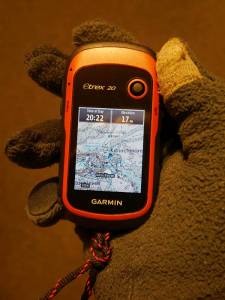It’s not my first GPS device. I’ve got half a dozen now counting this new eTrex, two running watches (Forerunner 305 and 310XT), a nüvi 1390T for driving, a chart plotter on the boat and an old 8-channel GPS 45XL (which was my first), but most were bought for different purposes and only that old 45XL is truly superfluous now.
So why another GPS for the hill when map and compass works? And map and compass backed up by GPS grid refs (which I can get from the Forerunner 310XT) also works? Because map and compass backed up by mapping GPS or mapping GPS backed up by map and compass are quite simply slicker options. Until just under four years ago, I navigated the hills almost exclusively by map and (when necessary) compass. Then, after moving from a non-OS-grid-enabled GPS watch (Forerunner 305) to one that could give an OS grid ref (Forerunner 310XT), I added that to my armoury. But the 310XT’s still not primarily a navigating device, I like to keep moving in the hills (especially when dressed/equipped for running rather than walking/climbing) and find that stopping to transfer grid refs to map tends to interrupt my flow when doing so. So, just as I’ve moved from 1. just compasses, Breton plotters and paper charts for coastal navigation through 2. transferring lat and long from simple GPS to paper chart to 3. GPS chart plotter, I’ve found myself wanting a mapping GPS for the hill. And this new eTrex is light, compact, map-capable and relatively inexpensive with excellent battery life to boot. Not, retrospectively, the very ‘best’ deal on offer when I’ve since seen the likes of the GPSMAP 62s with complete GB Discoverer 1:50K (almost map + free GPS!) for what I paid for eTrex 20 and downloadable 1:50K Scotland, but then I didn’t want a GPSMAP 62s anyway (bigger, heavier) even if it might be ‘better’ in some ways!
So how does it perform? Judging from one local test run today, absolutely fine. It sits comfortably in the hand with accessible, glove-operable controls and the transreflective screen, while possibly brighter in summer conditions, is still adequately readable in December ‘daylight’. It can also be squeezed into the lower front pockets of my UD Fastpack 20 (which just wouldn’t take a beefier model), though I’m not sure they’d be my first choice storage when I’ve been using one for my keys and the other for my thumb compass so far. And I managed to fit a lanyard of decent weight (trainer shoelace) to the built-in lanyard eye though it took some considerable fiddling to get it through. My only real gripe concerns my downloadable map from Garmin at £119.99, which turns out to be tied to the device when a pre-programmed Micro SD at the same £119.99 wouldn’t be. But what’s done is done, and it’s probably a largely academic distinction when you’d lose your non-tied card anyway if you lost the device and I’ve no plans to purchase any more compatible devices in the near future…











Just qualified ‘exclusively by map and (when necessary) compass’ in second paragraph by the addition of ‘almost’ after looking back at some old reports (eg Tranter’s Round, 3–4 July 2005) reminded me that I must very occasionally have taken the GPS 45XL on the hill (note the reference there to ‘poor GPS coverage’ on Carn Dearg SW!).
Comment by admin — 14 December 2014 @ 2:37 pm